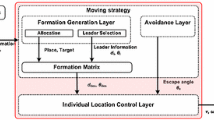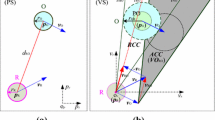Abstract
This paper addresses the obstacle avoidance problem of multiple mobile robots. We propose a method to address this problem, using a distributed robotic cooperative obstacle avoidance method with independent virtual center points which are set based on the current state of nearby robots and itself. Mobile robots use two different control modes: an obstacle-free mode, and an obstacle-avoidance mode. The control mode is switched on-line, based on the robot’s states which are shared information. Moreover, there is no limit to the number of mobile robots in the system of the proposed method. A control law is designed to guide the mobile robots to away from potential collisions and avoid congestion with other robots. The stability of the system is proved using a Lyapunov function. The effectiveness of the proposed method is evaluated using simulation studies and also real-world experimental verification. Experimental results show that the proposed method enables mobile robots to not only avoid collision with each other, but also significantly reduces the travel time and travel distance for situations with irregular distributions of multiple robots.
Similar content being viewed by others
References
Marzoughi, A.: A decentralized position estimation switching algorithm to avoid a convex obstacle. In: 2017 36th Chinese Control Conference(CCC), pp. 6031–6036 (2017)
Schwager, M., Rus, D., Slotine, J.J.: Unifying geometric, probabilistic, and potential field approaches to multi-robot deployment. Int. J. Robot. Res. 30(3), 371–383 (2010)
Cao, Y., Yu, W., Ren, W., Chen, G.: An overview of recent progress in the study of distributed multi-agent coordination. IEEE Trans. Ind. Inf. 9(1), 427–438 (2013)
Yao, Z., Gupta, K.: Distributed roadmaps for robot navigation in sensor networks. IEEE Trans. Robot. 27(5), 997–1004 (2011)
Zelazo, D., Franchi, A., Allgöwer, F.: Rigidity maintenance control for multi-robot systems. In: Robotics: Science & Systems VIII, pp. 504 (2012)
Pei, Y., Mutka, M.W., Xi, N.: Connectivity and bandwidth-aware real-time exploration in mobile robot networks. Wirel. Commun. Mob. Comput. 13(9), 847–863 (2013)
Lim, H., Kang, Y., Kim, J.: Formation control of leader following unmanned ground vehicles using nonlinear model predictive control. In: 2009 IEEE/ASME International Conference on Advanced Intelligent Mechatronics, pp. 945–950 (2009)
Rezaee, H., Abdollahi, F.: A decentralized cooperative control scheme with obstacle avoidance for a team of mobile robots. IEEE Trans. Ind. Electron. 61(1), 347–354 (2014)
Aguilar, L., Alami, R., Fleury, S., Herrb, M.: Ten autonomous mobile robots (and even more) in a route network like environment. In: International Conference on Intelligent Robots & Systems (1995)
van den Berg, J., Snoeyink, J., Lin, M., Manocha, D.: Centralized path planning for multiple robots: Optimal decoupling into sequential plans. In: Robotics: Science and Systems (2009)
Satici, A.C., Poonawala, H., Eckert, H., Spong, M.W.: Connectivity preserving formation control with collision avoidance for nonholonomic wheeled mobile robots. In: 2013 IEEE/RSJ International Conference on Intelligent Robots and Systems, pp. 5080–5086 (2013)
Min, H., Sun, F., Niu, F.: Decentralized uav formation tracking flight control using gyroscopic force. In: 2009 IEEE International Conference on Computational Intelligence for Measurement Systems and Applications, pp. 91–96 (2009)
Ranjbar-Sahraei, B., Shabaninia, F., Nemati, A., Stan, S.-D.: A novel robust decentralized adaptive fuzzy control for swarm formation of multiagent systems. IEEE Ind. Electron. Soc. 59(8), 3124–3134 (2012)
Howard, A., Matarić, M.J., Sukhatme, G.S.: Mobile sensor network deployment using potential fields: A distributed, scalable solution to the area coverage problem. In: The 6th International Symposium on Distributed Autonomous Robotics Systems (DARS02), pp. 299–308 (2002)
Gazi, V., Passino, K.M.: Stability analysis of social foraging swarms. IEEE Trans. Syst. Man Cybern. - Part B: Cybern. 34(1), 539–557 (2004)
Fagiolini, A., Tani, L., Bicchi, A.: Decentralized deployment of mobile sensors for optimal connected sensing coverage. In: IEEE International Conference on Distributed Computing in Sensor Systems, pp. 486–491 (2008)
Vadakkepat, P., Tan, K.C., Ming-Liang, W.: Evolutionary artificial potential fields and their application in real time robot path planning. In: The 2000 Congress on Evolutionary Computation, vol. 1, pp. 256–263 (2000)
Kowalczyk, W., Kozlowski, K.: Artificial potential based control for a large scale formation of mobile robots. In: Fourth International Workshop on Robot Motion and Control, pp. 285–291 (2004)
Jin, J., Gans, N.: Collision-free formation and heading consensus of nonholonomic robots as a pose regulation problem. Robot. Auton. Syst. 95, 25–36 (2017)
Peng, L., Guan, F., Perneel, L.: Decentralized multi-robot formation control with communication delay and asynchronous clock. J. Intell. Robot. Syst. 89(6), 1–20 (2017)
Qu, S., Chen, C., Dong, D.: Behavior-based control of swarm robots with improved potential field. In: Control Conference (2014)
Kwon, J.-W., Kim, J.H, Seo, J.: Consensus-based obstacle avoidance for robotic swarm system with behavior-based control scheme. In: 2014 14th International Conference on Control, Automation and Systems (ICCAS 2014), pp. 751–755 (2014)
Gyawali, P., Agarwal, P.K.: Fuzzy behaviour based mobile robot navigation in static environment. In: 2018 IEEE Recent Advances in Intelligent Computational Systems (RAICS), pp. 190–194 (2018)
Lee, D., Jeong, J., Kim, Y.H.: An improved artificial potential field method with a new point of attractive force for a mobile robot. In: International Conference on Robotics & Automation Engineering (2017)
Sudhakara, P., Ganapathy, V., Sundaran, K.: Route planning of a wheeled mobile robot (wmr) using enhanced artificial potential field (e-apf) method. In: 2018 International Conference on Communication, Computing and Internet of Things (IC3IoT), pp. 12–15 (2018)
Kao, C-C., Lin, C.-M., Juang, J.-G.: Application of potential field method and optimal path planning to mobile robot control. In: 2015 IEEE International Conference on Automation Science and Engineering (CASE), pp. 1552–1554 (2015)
Montiel, O., Sepúlveda, R., Orozco-Rosas, U.: Optimal path planning generation for mobile robots using parallel evolutionary artificial potential field. J. Intell. Robot. Syst. 79(2), 237–257 (2015)
Jin, J., Kim, Y., Wee, S., Lee, D., Gans, N.: A stable switched-system approach to collision-free wheeled mobile robot navigation. J. Intell. Robot. Syst. 86(3-4), 599–616 (2017)
Chen, D., Gong, G., Song, X.: An improved algorithm for motion graph and its application in intelligent obstacle avoidance. In: International Conference on Computer Application & System Modeling (2010)
Zhu, B., Li, C., Li, S.: A algorithm of global path planning based on the grid map and v-graph environmental model for the mobile robot. In: 2017 Chinese Automation Congress (CAC), pp. 4973–4977 (2017)
Che, H., Wu, Z., Kang, R.: Global path planning for explosion-proof robot based on improved ant colony optimization. In: 2016 Asia-Pacific Conference on Intelligent Robot Systems (ACIRS), pp. 36–40 (2016)
Yu, L., Wei, Z., Wang, H.: Path planning for mobile robot based on fast convergence ant colony algorithm. In: 2017 IEEE International Conference on Mechatronics and Automation (ICMA), pp. 1493–1497 (2017)
Faridi, A.Q., Sharma, S., Shukla, A., Tiwari, R.: Multi-robot multi-target dynamic path planning using artificial bee colony and evolutionary programming in unknown environment. Tell. Serv. Robot. 11, 171–186 (2018)
Das, P. K., Behera, H. S., Jena, P. K., Panigrahi, B. K.: Multi-robot path planning in a dynamic environment using improved gravitational search algorithm. Journal of Electrical Systems and Information Technology, pp. 295–313 (2016)
Best, G., Faigl, J., Fitch, R.: Multi-robot path planning for budgeted active perception with self-organising maps. In: 2016 IEEE/RSJ International Conference on Intelligent Robots and Systems (IROS), pp. 3164–3171 (2016)
Yu, J., LaValle, S.M.: Planning optimal paths for multiple robots on graphs. In: 2013 IEEE International Conference on Robotics and Automation (ICRA), pp. 3612–3617 (2013)
Das, P. K., Behera, H. S., Das, S.: A hybrid improved pso-dv algorithm for multi-robot path planning in a clutter environment. Neurocomputing 207, 735–753 (2016)
Tutsoy, O., Barkana, D.E., Colak, S.: Learning to balance nao robot using reinforcement learning with symbolic inverse kinematic. Trans. Inst. Meas. Control. 39(11), 1735–1748 (2016)
Qiu, J., Sun, K., Wang, T., Gao, H.: Observer-based fuzzy adaptive event-triggered control for pure-feedback nonlinear systems with prescribed performance. IEEE Transactions on Fuzzy Systems (2019)
Sun, K., Shaoshuai M., Jianbin Q., Wang, T., Gao, H.: Adaptive fuzzy control for non-triangular structural stochastic switched nonlinear systems with full state constraints. IEEE Transactions on Fuzzy Systems (2018)
Jin, J., Kim, Y.-G., Wee, S.-G., Gans, N.: Decentralized cooperative mean approach to collision avoidance for nonholonomic mobile robots. In: 2015 IEEE International Conference on Robotics and Automation (ICRA), pp. 35–41 (2015)
Juan, S.H., Juan, S.H., Cotarelo, F.H.: Multi-master ros systems. Technical Report Technical Report IRI-TR-15-01, Institut de Robòtica i Informàtica Industrial (2015)
Acknowledgements
This work is supported by the National Natural Science Foundation of China (Project No.: 61673115, 61803089), the Natural Science Foundation of Fujian Province, China (Project No.: 2017J01749) and by Program for New Century Excellent Talents in Fujian Province University, China. This work is also partly funded by the German Science Foundation(DFG) and National Science Foundation of China (NSFC) in project Cross Modal Learning under contract Sonderforschungsbereich Transregio 169.
Author information
Authors and Affiliations
Corresponding author
Additional information
Publisher’s Note
Springer Nature remains neutral with regard to jurisdictional claims in published maps and institutional affiliations.
Electronic supplementary material
Below is the link to the electronic supplementary material.
(MP4 9.84 MB)
Rights and permissions
About this article
Cite this article
Zhang, L., Wang, J., Lin, Z. et al. Distributed Cooperative Obstacle Avoidance for Mobile Robots Using Independent Virtual Center Points. J Intell Robot Syst 98, 791–805 (2020). https://doi.org/10.1007/s10846-019-01084-0
Received:
Accepted:
Published:
Issue Date:
DOI: https://doi.org/10.1007/s10846-019-01084-0




